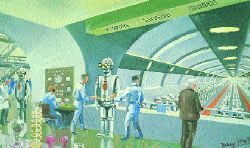A Noble Art / Jim Shaw

A fine, if unintended, equivalence took place when the creaking scholars of the British Museum and the style hyenas of the contemporary art world both decided to mount shows of amateur art. 'A Noble Art: Amateur Artists and Drawing Masters c. 1600-1800' at the British Museum, and Jim Shaw's collection 'Thrift Store Paintings' at the ICA differed enormously, but, at their best, were similarly defined by the particular energy of amateur practice. Shaw's collection comprises enjoyably bad works by unknown artists, bought cheaply from second-hand shops and flea markets across the USA, while the British Museum's exhibition, curated by Kim Sloan, is mostly from its own collection of drawings.
Included in 'A Noble Art' is Interior of Sir Ashton Lever's Museum, Leicester House, Leicester Square (c. 1835), an anonymous copy of a work made in 1786 by Sarah Stone. An intensely strange drawing, it belongs to the polite tradition of copying other artists' works, which dates back to the drawings and miniature watercolour copies of the 17th century. It has a correspondence with works in Shaw's collection, which includes similarly anonymous amateur copies of images from the worlds of rock, film or popular culture, also to weird effect. A couple of hundred years hence curators will presumably be writing about Shaw's paintings as Sloan does about her collection: long scholarly footnotes describing the nuanced relationship between Def Leppard and Darth Vader, or whoever is being honoured in these bedroom handiworks.
Shaw's choice of paintings, which are all undated, tends towards a camp psycho-kitsch, and the titles he gives them are their best descriptions: Yellow Surfer and Egg in Curl; Vietnam, LSD, JFK, Flag, Flowers etc; Depressive Figure in Concrete Landscape; Nude Children Peer into Psychedelic Hole in Ground; Drunken Mini-Skirted Woman with Arm around Asian Religious Statue; Nude Woman Reclining on Orange Bed with Semen on her Nipples. Viewed together in a compacted salon-style hanging, the effect was a crazy illustration of human dysfunction, tempting a critical lapse into an enjoyable hysteria of the John Waters/Pink Flamingos kind - rather than a recognition of the works as a high tribute to self-expression.
Unlike Shaw, part of whose showman act is to preserve the anonymity of his painters, Sloan, a hardcore academic, flattered even her most boring works - of which there were too many - with long and patient attention. After defining the confused meanings of the word 'amateur' and explaining its pejorative sense as being of relatively recent origin, she proceeded with some selective social history, much dull description of patronage and connoisseurship, as well as aspects of the class and gender prejudices that formed the complex cultural climate in which art was produced and taught at the time.
Apart from a few extraordinary works, such as A Pollard Oak near Westhampnett Place, Chichester (c. 1660), by John Dunstall, or the rampant homo-eroticism of Figure Studies after Rubens (undated), by Alexander Marshal (d. 1682), (main interest 'flowers and insects'), it was the competing issues of idealism and commercialism that defined Sloan's exhibition. 'Amateurism' was an ideology, privileging the non-professional over the professional artist, but it became a self-certifying, class-based moral superiority. Sloan, though, exceeded even this, with an incurable zeal, concluding that artists often deliberately drew badly so as not to compromise their amateur status and invoke social stigma by being thought too professionally able. This is disproved by the catalogue illustrations, and it may be that Sloan has taken too literally the genteel euphemisms and coded understatements of the British class system of the time, whose guardedness at the sensitive boundary between professional and non-professional practice may have been slightly less acute than she assumes.
It's a boundary that continues in Shaw's show. Although, as in Sloan's, attribution, provenance and other criteria of judgement - even aesthetic merit - become less important, or displaced in new and interesting ways, the divide between professional and amateur remains. 'Thrift Store Paintings' is as much an exercise about the enforcing of professional status and its new identity categories, as the amateurism of its subject - Shaw practising the overlapping professional roles of dealer-collector, curator and artist-producer to perfection.
It would be nice to say that the pot-head casualties, psychos, weirdos, wackos, and late-night innocents who created Shaw's show had proved a return to the original use of the word 'amateur,' meaning to love. But they didn't. They were too far gone. Still, in a world where fine art is often recognized less by its craft skills than by authorial pronouncement and context, it was a pleasure to see that professionals don't have a monopoly on crap art, and that even amateurs can succeed in doing it badly.
















